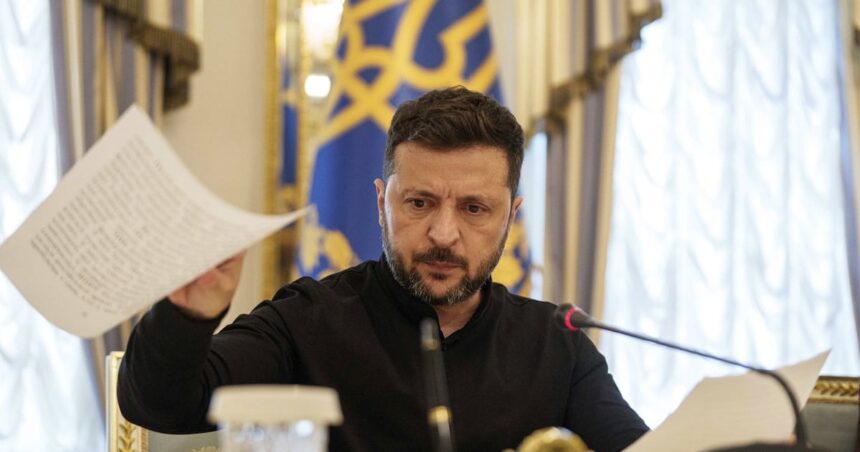I stood at the edge of a hastily constructed defensive berm near Sumy, watching Ukrainian soldiers plant anti-personnel mines in a precise pattern across what was, until recently, fertile farmland. The June heat was oppressive, but the men worked methodically, their movements betraying the urgency of their task. This northeastern region faces renewed pressure from Russian forces massing just kilometers away.
“We have no choice,” explained Colonel Vasyl Kravchenko, wiping sweat from his brow. “These mines will buy us time. Time we desperately need.“
This scene took on new significance yesterday when President Volodymyr Zelenskyy signed a decree officially withdrawing Ukraine from the Ottawa Treaty—the landmark 1997 agreement banning the use, production, and transfer of anti-personnel landmines. The move marks a significant shift in Ukraine’s defensive strategy and raises profound questions about the balance between immediate security needs and long-term humanitarian considerations.
The Ukrainian government’s decision reflects the harsh realities of a conflict entering its third brutal year. According to Defense Ministry statistics, Russian forces currently control approximately 20% of Ukrainian territory, with frontline positions stretching over 1,200 kilometers. Ukrainian military analysts point to critical manpower shortages, with Russia maintaining a roughly 4:1 advantage in troop numbers along most active fronts.
“When you are outnumbered and fighting for national survival, you use every tool available,” said Olha Stefanishyna, Ukraine’s Deputy Prime Minister for European Integration, during a press briefing in Kyiv. “This is not a decision taken lightly, but one made necessary by Russia’s continued aggression and our defensive requirements.”
The Ottawa Treaty, formally known as the Convention on the Prohibition of the Use, Stockpiling, Production and Transfer of Anti-Personnel Mines and on their Destruction, has been a cornerstone of international humanitarian law since it entered into force in 1999. Ukraine became a signatory in 1999 and ratified the treaty in 2005, committing to never use anti-personnel mines and to clear existing minefields.
This withdrawal doesn’t happen in a vacuum. The Ukrainian military has already been using anti-tank mines throughout the conflict, which remain legal under the Ottawa Treaty. What changes now is Ukraine’s ability to deploy anti-personnel mines—smaller devices designed specifically to target infantry—which military planners view as crucial for slowing Russian advances across open terrain.
“We are facing an existential threat from a nation that has never signed the Ottawa Treaty and extensively uses the very weapons we’ve denied ourselves,” said General Oleksandr Syrskyi, Commander-in-Chief of Ukraine’s Armed Forces, in a statement supporting the decision.
Russia, which has never joined the treaty, has deployed extensive minefields throughout occupied territories. According to United Nations estimates, Ukraine is now among the most heavily mined countries globally, with approximately 174,000 square kilometers potentially contaminated—an area larger than England, Scotland and Wales combined.
International reaction has been mixed. While Western military analysts acknowledge Ukraine’s tactical predicament, humanitarian organizations have expressed alarm.
“This represents a dangerous precedent that threatens to undermine decades of progress,” said Sara Megan, director of the International Campaign to Ban Landmines. “Landmines are inherently indiscriminate weapons that will continue killing and maiming civilians long after conflicts end.“
The human cost of landmines in Ukraine is already staggering. According to the UN Mine Action Service, at least 2,500 civilians have been killed or injured by mines and explosive remnants of war since February 2022. Clearance operations are expected to take decades and cost billions.
In Kharkiv region, I met Dmytro Kovalenko, a 34-year-old farmer who lost his right leg to a landmine while checking on his property last winter. “I understand why our army needs these weapons,” he told me from his rehabilitation center. “But I also know firsthand what they do to ordinary people. This will be our burden for generations.”
Ukrainian officials have attempted to mitigate international concerns by emphasizing that their use of anti-personnel mines will be “strictly defensive, meticulously documented, and primarily deployed along active front lines.” Defense Ministry spokespeople stress that Ukraine will maintain its commitment to extensive mine clearance once the conflict ends.
Military experts point out that defensive minefields could help compensate for Ukraine’s artillery ammunition shortages. The Ukrainian military currently fires approximately 2,000 artillery shells daily—far below the 10,000 shells Russia launches, according to Western intelligence assessments.
“Mines are a force multiplier,” explained Franz-Stefan Gady, a military analyst at the International Institute for Strategic Studies. “They channel enemy movements, protect flanks, and allow defenders to concentrate limited forces where they’re most needed.”
The withdrawal takes effect in six months, per treaty provisions. Ukraine joins the United States, Russia, China, Iran, and India among major powers not party to the agreement. Currently, 164 states are parties to the treaty.
For Ukrainian commanders like Kravchenko, the debate feels distant from frontline realities. “We’re fighting against an enemy that respects no treaties, no rules of war,” he said as we walked the perimeter of his unit’s position. “My responsibility is to protect my soldiers and my country with whatever means necessary.”
As I departed the defensive position near Sumy, I watched soldiers carefully marking their newly laid minefield with warning signs—a bitter acknowledgment that today’s desperate measures will create tomorrow’s humanitarian challenges.






